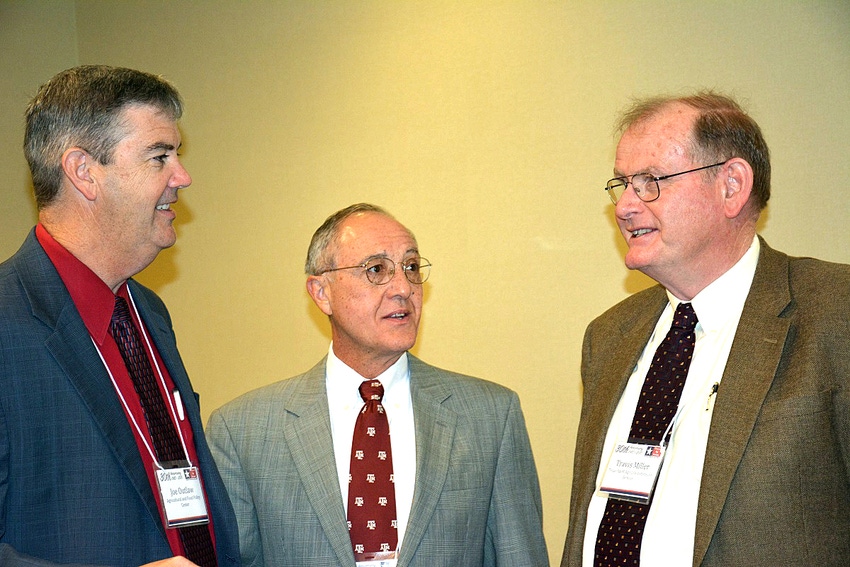
During the webinar, one of a series University of Arkansas Extension agricultural economists have been conducting on the farm bill, Dr. Richardson described how farmers can use “magic” or generic base acres to increase the payments they may receive from the farm bill’s ARC and PLC programs.
March 4, 2015

Some farmers and landowners may have breathed too much of a sigh of relief when Agriculture Secretary Tom Vilsack announced a decision to extend the 2014 farm bill’s Feb. 27 deadline for base reallocation and yield updates to March 31.
The Texas A&M University Farm Bill Decision Aid website had been hosting from 2,000 to 2,200 sessions per day for growers trying to analyze their options for enrolling in the Agricultural Act of 2014 during the weeks leading up the deadline.
That number dropped by more than 50 percent when rumors began spreading that Vilsack would announce an extension on Feb. 26 and by a similar amount when the delay became official on Feb. 27, said James Richardson, co-director of Texas A&M University’s Agricultural and Food Policy Center. The AFPC developed the decision aid under contract with USDA.
“It’s like farmers decided to take a recess when the announcement of the extension was made,” said Dr. Richardson, speaking during a University of Arkansas Extension Service Webinar: 2014 Farm Bill Decision: Deploying Generic Base Acres. “That was the wrong thing to do. We need farmers to step up and complete base reallocations and update their yields and not wait until the next deadline.”
During the webinar, one of a series University of Arkansas Extension agricultural economists have been conducting on the farm bill, Dr. Richardson described how farmers can use “magic” or generic base acres to increase the payments they may receive from the farm bill’s ARC and PLC programs.
Richardson, who has been analyzing farm bill programs for 40 years at Texas A&M, said the generic-base concept was included in the 2014 farm bill because of what happened in the past when farmers experienced changes in acreage bases.
Allotment debacle
“When they did away with allotments in the 1960s and 1970s, it was a real debacle,” he said. “The same thing happened when they canceled the allotments for peanuts. A lot of farmers lost the net worth they had built with their acreage bases.”
When it became obvious cotton producers would have to make drastic changes in the U.S. cotton program because of the WTO case brought by Brazil, some members of Congress were determined to prevent the same from occurring in 2015.
The result was that cotton base acres became generic base acres, which could be applied to the base acres growers have for the 22 other crops that continued to be covered by the farm programs in the 2014 farm bill.
“As long as a farmer plants more acres of covered crops than the number of generic base acres on that farm, all of the generic base acres can be deployed to covered crops, such as peanuts, corn, soybeans, grain sorghum and wheat,” said Dr. Richardson.
Using the Texas A&M University Farm Bill Decision Aid, growers can see what impact reallocating their generic base acres to other crops can have on their individual FSA farm numbers, he said. To date, Texas A&M has recorded 110,000 sessions with farmers using the Decision Aid to determine the outcome of different choices under the farm bill.
Updates continuing
Dr. Richardson said the Agricultural and Food Policy Center, which began work on the Decision Aid two years before the farm bill was signed, is continuing to make changes to the Decision Aid to try to give producers the best assistance possible.
“We’re still having problems with yields that haven’t been provided for some counties, and we’re adding those as quickly as we can,” he said. “I think that’s one reason they extended the deadline for updating yields and base reallocations.”
The AFPC also plans to add a new feature that will enable growers to drop low years when they are calculating their average yields. “We think it will allow growers to buy lower levels of insurance coverage and get more protection.”
Farm Service Agency staff members say they are seeing more farmers come in to county FSA offices and complete base reallocations and yield updates.
“That may be one reason the number of Decision Aid sessions dropped off at the end of the month,” said Anita Wilson, agricultural program specialist for FSA in Arkansas. “We did have more producers coming in and completing those steps right before the deadline.”
For growers who wish to use the Decision Aid, it can be found at https://decisionaid.afpc.tamu.edu.
About the Author(s)
You May Also Like





